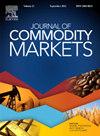欧盟排放交易体系与企业回报之间的关联:来自高排放和低排放企业的证据
IF 4.5
4区 经济学
Q1 BUSINESS, FINANCE
引用次数: 0
摘要
本研究采用整合时频分解和块级分析的连通性框架,分析了欧盟碳排放交易体系(本文将其作为碳价格动态的代理)与欧盟碳排放交易体系第三和第四阶段(2013年1月1日至2025年4月30日)不同排放水平的欧洲企业的股票收益之间的波动性传递。实证证据证实,碳市场波动显著影响企业财务动态,特别是在短期内,特别是对高排放企业。这些结果验证了提出的三个假设:(1)碳和股票市场之间存在统计上显著的波动关联性;(ii)短期溢出效应占主导地位;(三)高排放企业比低排放企业更容易受到波动率传导的影响。这些发现在两种不同的分类标准中都是强有力的,并突出了碳定价不仅作为环境政策工具,而且作为金融市场信号的相关性。本文章由计算机程序翻译,如有差异,请以英文原文为准。
Block connectedness between the EU-ETS and corporate returns: Evidence from high- and low-emission firms
This study analyzes volatility transmission between the EU-ETS –used here as a proxy for carbon price dynamics– and the stock returns of European firms with varying emission levels during the third and fourth phases of the EU-ETS (from January 01, 2013 to April 30, 2025), applying a connectedness framework that integrates time-frequency decomposition and block-level analysis. The empirical evidence confirms that carbon market volatility significantly affects corporate financial dynamics, especially in the short term and particularly for high-emission firms. These results validate the three hypotheses posed: (i) there is statistically significant volatility connectedness between carbon and stock markets; (ii) short-term spillovers dominate; and (iii) high-emission firms are more exposed to volatility transmission than their low-emission counterparts. These findings are robust across two different classification criteria and highlight the relevance of carbon pricing not only as an environmental policy tool but also as a financial market signal.
求助全文
通过发布文献求助,成功后即可免费获取论文全文。
去求助
来源期刊

Journal of Commodity Markets
Multiple-
CiteScore
5.70
自引率
2.40%
发文量
53
期刊介绍:
The purpose of the journal is also to stimulate international dialog among academics, industry participants, traders, investors, and policymakers with mutual interests in commodity markets. The mandate for the journal is to present ongoing work within commodity economics and finance. Topics can be related to financialization of commodity markets; pricing, hedging, and risk analysis of commodity derivatives; risk premia in commodity markets; real option analysis for commodity project investment and production; portfolio allocation including commodities; forecasting in commodity markets; corporate finance for commodity-exposed corporations; econometric/statistical analysis of commodity markets; organization of commodity markets; regulation of commodity markets; local and global commodity trading; and commodity supply chains. Commodity markets in this context are energy markets (including renewables), metal markets, mineral markets, agricultural markets, livestock and fish markets, markets for weather derivatives, emission markets, shipping markets, water, and related markets. This interdisciplinary and trans-disciplinary journal will cover all commodity markets and is thus relevant for a broad audience. Commodity markets are not only of academic interest but also highly relevant for many practitioners, including asset managers, industrial managers, investment bankers, risk managers, and also policymakers in governments, central banks, and supranational institutions.
 求助内容:
求助内容: 应助结果提醒方式:
应助结果提醒方式:


